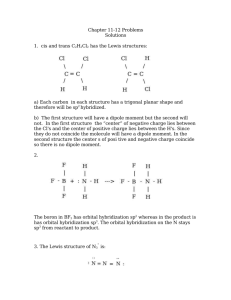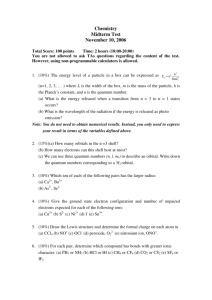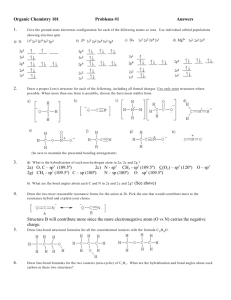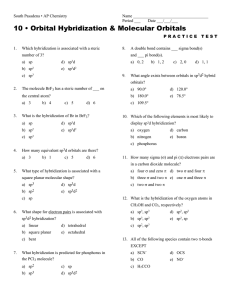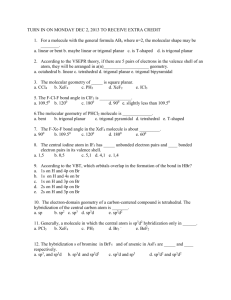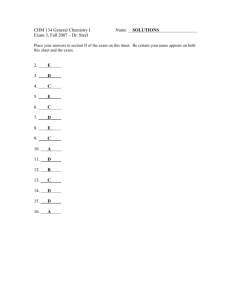9-1
advertisement
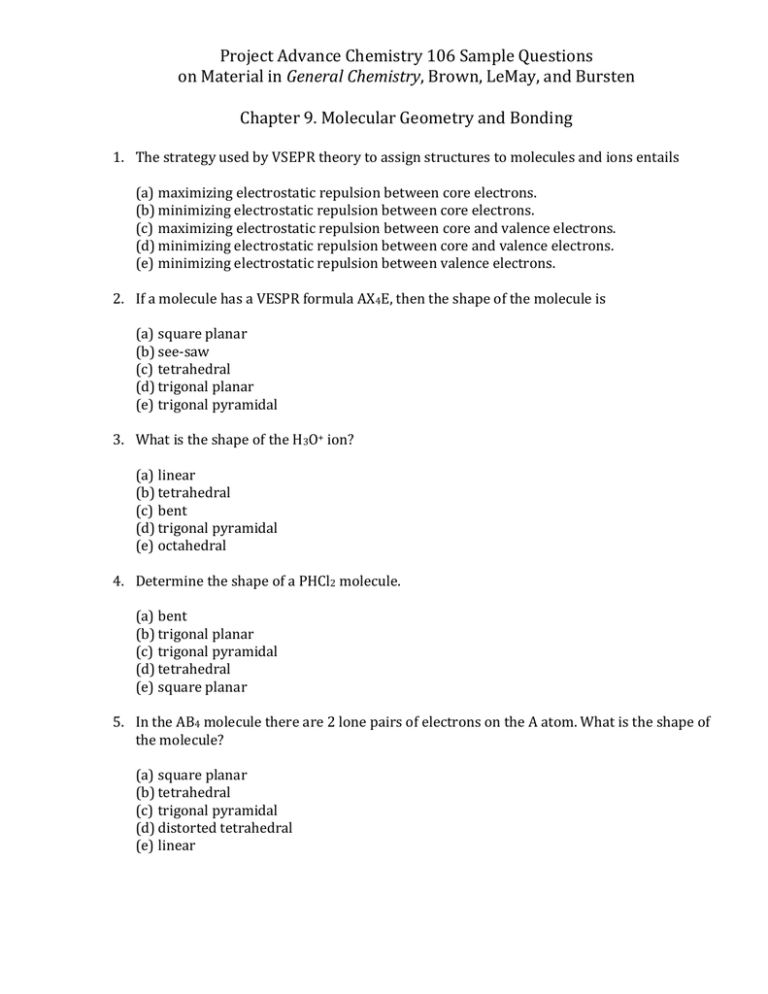
Project Advance Chemistry 106 Sample Questions on Material in General Chemistry, Brown, LeMay, and Bursten Chapter 9. Molecular Geometry and Bonding 1. The strategy used by VSEPR theory to assign structures to molecules and ions entails (a) maximizing electrostatic repulsion between core electrons. (b) minimizing electrostatic repulsion between core electrons. (c) maximizing electrostatic repulsion between core and valence electrons. (d) minimizing electrostatic repulsion between core and valence electrons. (e) minimizing electrostatic repulsion between valence electrons. 2. If a molecule has a VESPR formula AX4E, then the shape of the molecule is (a) square planar (b) see-saw (c) tetrahedral (d) trigonal planar (e) trigonal pyramidal 3. What is the shape of the H3O+ ion? (a) linear (b) tetrahedral (c) bent (d) trigonal pyramidal (e) octahedral 4. Determine the shape of a PHCl2 molecule. (a) bent (b) trigonal planar (c) trigonal pyramidal (d) tetrahedral (e) square planar 5. In the AB4 molecule there are 2 lone pairs of electrons on the A atom. What is the shape of the molecule? (a) square planar (b) tetrahedral (c) trigonal pyramidal (d) distorted tetrahedral (e) linear 6. How many π bonds are in the molecule shown below? (a) 7 (b) 6 (c) 2 (d) 1 (e) none of these. 7. The sp2 hybrid orbital set contains how many orbitals? (a) 2 (b) 3 (c) 4 (d) 5 (e) 6 8. The respective hybridization of nitrogen in NF3 and NH3 (a) sp2 and sp2 (b) sp and sp3 (c) sp3 and sp (d) sp3 and sp3 (e) sp2 and sp3 9. The respective hybridization of bromine in BrF5 and arsenic in AsF5 are (a) sp3 and sp3d (b) sp3d and sp3d2 (c) sp3d and sp3 (d) sp3d2 and sp3d (e) sp3d2 and sp3d2 10. The hybrid orbitals used for bonding by the sulfur atom in SF4 are (a) sp (b) sp2 (c) sp3 (d) sp3d (e) none of these. 11. The AsF5 molecule is trigonal bypyramidal. The hybrid orbitals used by the As atom for bonding are (a) sp2d2 (b) sp3 (c) sp3d (d) sp3 d2 (e) none of these. 12. What type of hybrid orbitals are used for bonding by Xe in the XeF4 molecule? (a) sp2 (b) sp3 (c) sp3d (d) sp3d2 (e) none of these. 13. The Lewis dot structure of carbon monoxide is :C ≡ O: . The respective hybridizations of carbon and oxygen are (a) sp and sp3 (b) sp2 and sp3 (c) sp3 and sp2 (d) sp and sp (e) sp2 and sp2 14. The hybridization of the central carbon is H2C = C = CH2 is (a) sp (b) s2p (c) sp2 (d) s2p2 (e) sp3d 15. The hybridization of the terminal (non-central) carbons in H2C = C = CH2 is (a) sp (b) sp2 (c) sp3 (d) sp3d (e) sp3d2 16. The hybridization of the nitrogen in H—C ≡ N is (a) sp (b) s2p (c) s3p (d) sp2 (e) sp3 17. How many unhybridized p-atomic orbitals are there on an sp hybridized carbon atom? (a) O (b) 1 (c) 2 (d) 3 (e) none of these. 18. What is the hybridization of the carbon atom labeled X? (a) sp (b) sp2 (c) sp3 (d) sp3d (e) none of these. 19. Molecular orbital theory describes bonding in H2 as having (a) both the 1sσ and 1sσ* orbitals filled. (b) the 1sσ orbital filled and the 1sσ* orbital empty. (c) the 1sσ orbital filled and the 1sσ* orbital half-filled. (d) the 1sσ orbital half-filled and the 1sσ* orbital filled. (e) the 1sσ orbital empty and the 1sσ* orbital filled. 20. The general energy-level diagram for molecular orbitals of second-row diatomic molecules predicts which of the following to be paramagnetic? (a) O2 only (b) N2 only (c) N2 and B2 (d) N2 and O2 (e) B2 and O2 21. According to Molecular Orbital Theory, how many unpaired electrons are there in the molecular species OF+ ? (a) 0 (b) 3 (c) 1 (d) 2 (e) none of these. 22. Using Molecular Orbital Theory, determine the bond order of N22+ . (a) 0 (b) 3 (c) 1 (d) 2 (e) none of these. 23. According to Molecular Orbital Theory, what is the bond order of the Be2 molecule. (a) 0 (b) 1 (c) 2 (d) 3 (e) none of these. 24. Which of the following molecular species is paramagnetic? (a) N2 (b) C22+ (c) F2 (d) B2+ (e) none of these. 25. Using Molecular Orbital Theory, determine the bond order of the C2 molecule. (a) 0 (b) 1 (c) 2 (d) 3
